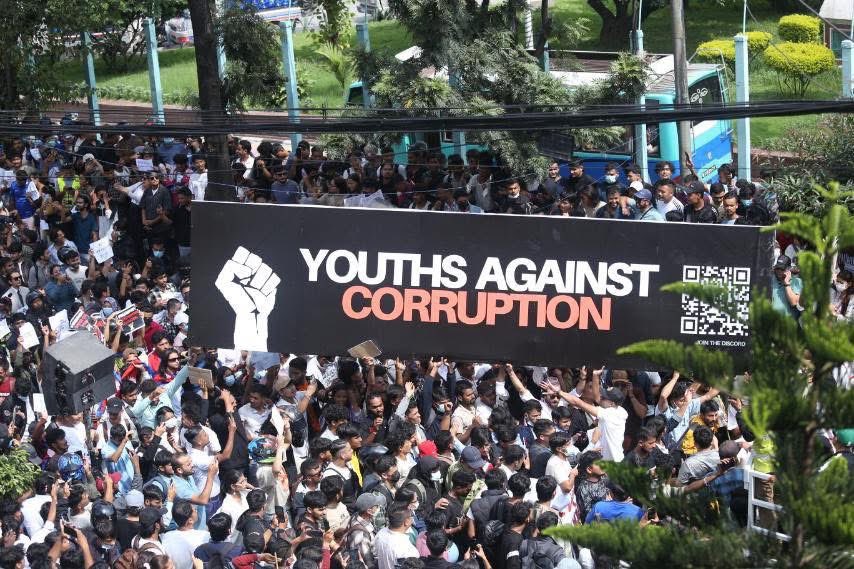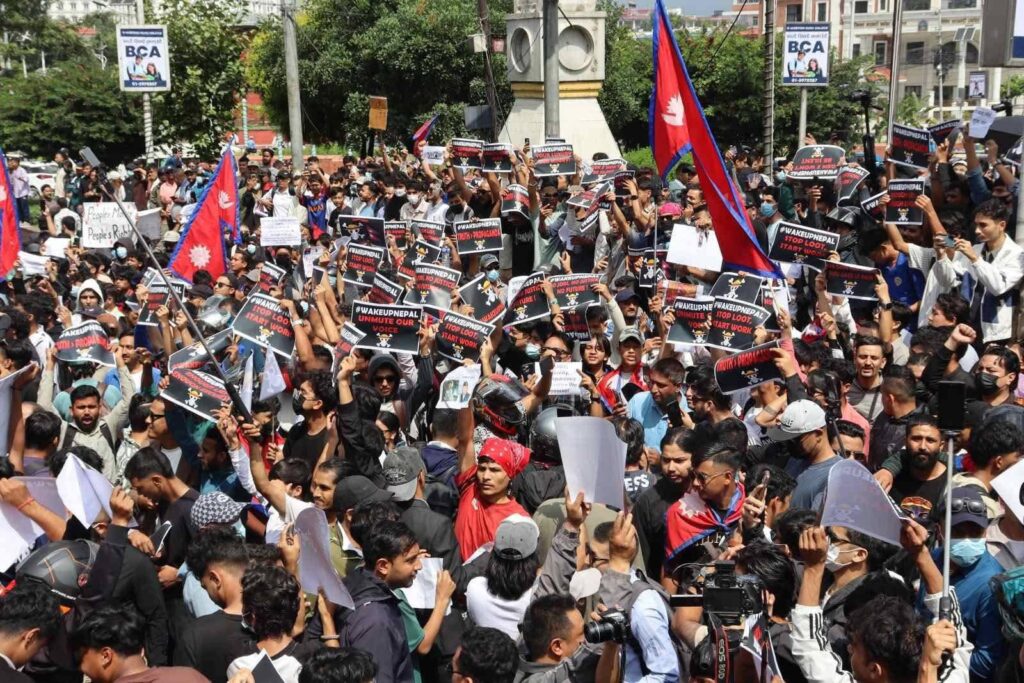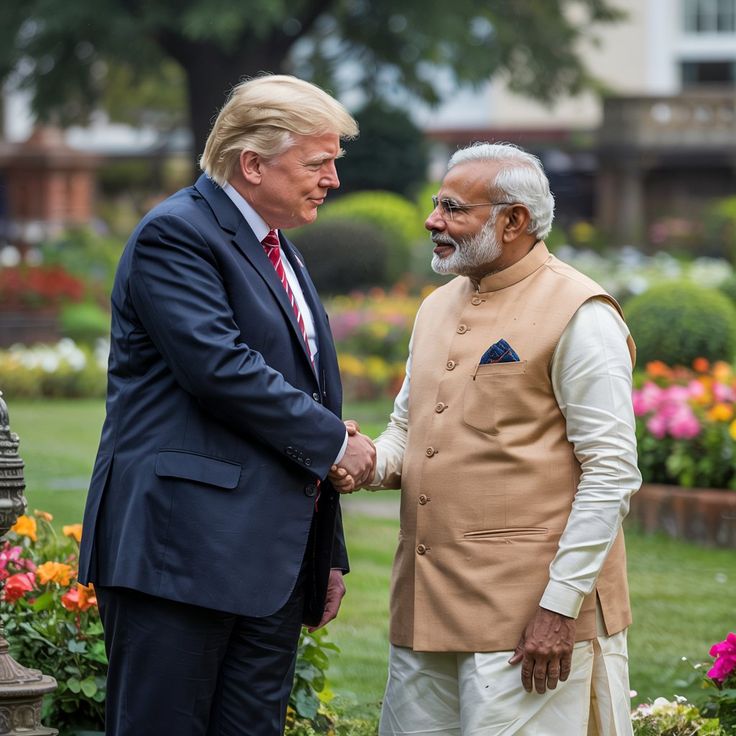The Day Nepal’s Youth Said “Enough”
On a warm September morning in Kathmandu, thousands of young Nepalis poured onto the streets, waving flags, holding placards, and chanting in unison. A government-imposed ban on social media sites sparked uproar, which quickly turned into one of the biggest youth-led demonstrations in Nepal’s recent history.
The demonstrations, led by Generation Z—young people born roughly between 1995 and 2010—were more than just about Facebook, Instagram, or YouTube. They represented a collective cry for dignity, freedom, and accountability in a nation struggling with corruption, unemployment, and a disillusioned political system.
But the day would soon turn tragic. Police used water cannons, rubber bullets, tear gas, and finally live shot to scatter the demonstrators. By nightfall, at least 19 people were dead and over 250 injured. The protests had claimed lives but ignited something far larger: a generational movement demanding change.
The Trigger: Social Media Ban That Broke the Dam
On September 4, 2025, the Nepalese government announced a ban on 26 major social media platforms including Facebook, Instagram, WhatsApp, YouTube, Snapchat, and X (formerly Twitter). Officials argued that the platforms had failed to register under new digital regulations and posed a “risk to national security.”
But for young Nepalis, who rely on these platforms for communication, business, education, and activism, the ban felt like an authoritarian overreach.
- Students lost their learning platforms.
- Small businesses lost their digital storefronts.
Activists lost their voice.
The slogan of the protests captured this sentiment perfectly:
“Stop corruption, not social media!”
From Hashtags to Streets: How Gen Z Mobilized
Ironically, even with platforms banned, Nepal’s youth found ways to organize. Using VPNs, TikTok, and encrypted apps, they spread the word. The trending hashtag #NepoKids—which began as a critique of nepotism in politics—quickly merged with anti-ban sentiment, giving the movement both direction and identity.
On September 8, 2025, thousands of young protesters converged at Maitighar Mandala, a symbolic protest site in Kathmandu. Many wore school uniforms or university jackets, highlighting that this was not just a political march but a generational statement.
Placards read:
- “Unban Social Media, Unban Our Future”
- “We Are Gen Z, We Want Change”
- “Shut Down Corruption, Not WiFi”
The digital natives had officially gone analog—marching, chanting, and reclaiming the streets.
The Violent Turn: Confrontation at Parliament
By noon, the protesters had marched towards the Parliament complex, chanting slogans and waving Nepal’s red and blue national flags. The atmosphere was both festive and defiant.
But as crowds surged against barbed-wire barricades, police forces escalated their response.
First came tear gas and water cannons. Protesters, many of them teenagers, shielded themselves with homemade masks and wet handkerchiefs. When police lines broke, young demonstrators pushed forward, some tearing down barriers and forcing officers to retreat.
- What followed shocked the nation: police opened fire with live ammunition.
- Eyewitnesses described chaos: People running, students carrying bleeding friends, and smoke filling the air.
- Journalists were caught in the crossfire, with some injured while covering the protests.
- Hospitals overflowed as ambulances rushed victims from the protest site.
By evening, the death toll had risen to 19, with over 250 injured—including protesters, police officers, and bystanders.
Human Stories: Faces Behind the Protest
The tragedy is not just in the numbers but in the human lives affected.
- Ikshama Tumrok, 20, a college student:
“We want to see change. Our parents tolerated corruption and unemployment, but our generation will not. This ends with us.” - A 17-year-old protester :
“I was standing next to my friend when the police fired. The bullet missed me but hit him in the arm. I will never forget that moment.” - Local shopkeeper near Maitighar:
“These kids are fighting for something bigger than social media. They are fighting for their future.”
These testimonies reflect the deeper reality: the protests are about systemic frustration, not just apps.
Government’s Response: Curfews, Resignations, and Denials
As images of the crackdown spread globally, the government scrambled to contain the fallout.
- A curfew was imposed in several important Kathmandu locations, such as the vicinity of the presidential palace and Parliament.
- The deployment of the army demonstrated how severe the situation was.
- After accepting “moral responsibility” for the carnage, Home Minister Ramesh Lekhak resigned.
- Yet, the administration defended the social media ban, framing it as a matter of “digital sovereignty” and accusing protesters of being “misled by foreign influences.”
This only deepened anger among the youth, who saw it as proof of a government out of touch with reality.
Global Reaction: Rights Groups Condemn Violence
The world took notice of Nepal’s turmoil:
- Amnesty International called the use of live ammunition against protesters “a violation of international law” and demanded an independent investigation.
- Human Rights Watch urged Nepal to lift restrictions on free speech and ensure accountability for police violence.
- International media outlets described the protests as Nepal’s “Gen Z Uprising,” drawing parallels to youth movements in Hong Kong, Myanmar, and the Arab Spring.
The crisis was no longer a domestic issue—it had become a global talking point on democracy and youth rights.
Why Gen Z? The Deeper Roots of Anger
While the spark was the social media ban, the fuel was long-standing grievances:
1. Corruption: Decades of political instability and alleged misuse of public funds have eroded trust.
2. Unemployment: With limited job opportunities, many young Nepalis feel their future is shrinking.
3. Digital Dependence: For a generation raised online, cutting off social media is like cutting off electricity.
4. Generational Disconnect: Older politicians dominate decision-making, while young voices remain excluded.
This is why the protests quickly transformed from a single-issue demonstration into a civil rights movement.
Comparisons: Nepal in the Global Youth Wave
Nepal’s Gen Z protests echo other youth-led movements:
- Hong Kong (2019): Students mobilized against Beijing’s influence.
- Iran (2022): Gen Z women led protests for freedom after Mahsa Amini’s death.
In each case, digital-native generations used technology to resist entrenched powers. Nepal’s protests are now part of this global tapestry.
What Lies Ahead: Uncertainty and Hope
As the dust settles, key questions remain:
- Will the government reverse the social media ban?
- Will there be accountability for the killings?
Can Nepal’s political class engage meaningfully with its youth?
For now, curfews remain, soldiers patrol Kathmandu, and parents mourn their children. But one thing is clear: However, one thing is certain: Nepal’s Generation Z has discovered its voice and will not be easily hushed.
A Generation’s Defining Moment
The tragic events of September 2025 will be remembered as a watershed moment in Nepal’s history. What began as a protest against a digital blackout has become a symbol of generational awakening.
Nepal’s youth—born after the civil war, raised in the digital age, and weary of corruption—have shown that they are willing to risk everything for freedom and dignity.
The movement is no longer just about unblocking apps. It is about unblocking the future.
As one protester’s banner read:
“We are not the future of Nepal. We are the present.”
Related News: Read More




